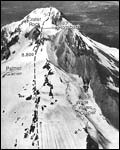
|
A Deadly Week on the Cascade Volcanoes Helicopter Crash Underscores Danger for Rescuers The Pacific Northwest - May 31, 2002 The Climbing Routes: Mt. Hood | Mt. Rainier
The past four days have seen tragic climbing accidents on Oregon's Mount
Hood
and Washington's Mount Rainier, two of the most popular of the Cascade
volcanoes. The Hood accident was followed by the incident rescuers fear
most: the crash of a rescue helicopter.
The incidents hit especially close to home for me, and not just because I'm a mountaineering journalist: the accidents occurred on routes that are included in the guidebook to the range, Selected Climbs in the Cascades, that I wrote with Jim Nelson. And the helicopter incident is eerily familiar to one I experienced myself in 1988. After a bone-crushing leader fall deep in the wilderness Cascades, I was plucked from a mountain side by a courageous army helicopter pilot who made multiple attempts to retrieve me, and had to contend with the same problems that plagued the rescuers on Mount Hood: downdrafts and holding a hover at high altitude. According to chief climbing ranger at Mount Rainier National Park, Mike Gauthier, the facts of the Liberty Ridge accident are these: last weekend, a party of four climbers, including 21-year-old Keeta Owens and Corneilius Beilharz, 26, both students from Oregon State University, and two friends from Germany, Grit Kleinshchmidt, 26, and Andreas Kurth, 29, set out to climb Liberty Ridge on 14,410-foot Mount Rainier. The route is usually done in three to five days: two days to high camp at Thumb Rock (10,500 feet on Liberty Ridge), a day on the upper ridge, then down, usually by the Emmons Glacier route, as Liberty Ridge is too technical to descend safely. Many parties camp on or near the summit, others climb the upper ridge and descend the same day. The route is more technical than most glacier routes on the mountain, but it's chief characteristic is that it is committing: descent down the ridge is difficult. The climbers were on schedule, camping Sunday night at Thumb Rock, Gauthier said. Climbers who had seen them report that they were moving well. But the party made slow progress Monday and only just reached the top of the ridge, according to Gauthier. The climbers decided to bivouac near Liberty Cap when their GPS equipment became inoperable in the freezing rain, making route-finding for the descent impossible in the bad conditions. Tuesday the weather worsened yet, and the party was forced to make yet another bivouac in shallow snow caves. One member of the party, Beilharz, apparently fell to his death during the night; another, Kurth, fell but survived, and the next day managed to descend (climbing despite the fact one of his plastic climbing boot had been lost in the fall) the Winthrop Glacier solo. Rangers state he was lucky not to have fallen in a crevasse while climbing alone and unroped. When the climber encountered another party near St. Elmo Pass, he borrowed a cell phone to alert rangers to the accident. The response was quick, but both women were dead when rangers reached the scene of the bivouac; their bodies were found approximately 350 feet below the bivouac site. "This was especially tough," said Gauthier. "I've been on a lot of recoveries, but never for female climbers before. And these people were mostly very young. It's never easy, but this one has hit us especially hard." On Mount Hood, the usual crowds were ascending the popular South Side route on the 11,237-foot mountain, sometimes called the Hogsback or Palmer Snowfield route. It's one of the most popular moderate routes on any volcano in the range. I climbed it first in 1980, leaving at sunset so my partners and I could climb under a full moon and have the route to ourselves. An ascent normally is done in a day, with no camp, as the ski area on the south side of Hood makes for excellent access to this route. The South Side route is not technically demanding in most conditions, but on Thursday the route was particularly icy near the top, where the route narrows before entering the so-called "chute," a steep gully that leads to the summit. Rangers reported that one party of two climbers, roped together, lost footing and fell. As those climbers tumbled down the mountain, out of control, they became entangled with another party of three climbers just below them. The second party was dragged down the mountain as well. All of the climbers were now falling, and yet a third party of climbers were caught up in the fall. All the falling climbers ended up in a crevasse at approximately 10,500 feet. Three climbers were killed: John Biggs, 62, of Windsor, California, and William Ward, 49, and Richard Read, 48, of Forest Grove, Oregon. Thursday afternoon, a U.S. Air Force Pave Hawk helicopter attempted to rescue the surviving climbers from the area of the crevasse. But the dramatic footage shown worldwide on television clearly revealed that the machine lost lift, wobbled, and crashed into the slope. It then tumbled for several hundred feet before coming to a rest. Fortunately, none of the six man crew was killed, but several were seriously injured. It was a bleak day for climbers in the Cascades, a great range for climbing, but it was not the worst day. That dubious distinction goes to an incident on Mount Rainier in June 1981, when an ice cliff avalanched, killing 11 people. An incident on Mount Hood in 1986 also claimed 11 lives, when a group of students and teachers were caught in bad weather and perished before rescuers could reach them. These incidents underscore the danger of climbing on the Cascade volcanoes. They are some of the most appealing peaks in the lower 48, clad with glaciers and ice that give the feel of big mountains. But conditions can change rapidly, allowing minor incidents to escalate into major disasters. Weather and white-out contribute to most accidents recorded on the peaks. I climbed in the Cascades for decades thinking I would not experience an accident myself. That changed in 1988, when I took a 150-foot leader fall on Chimney Rock, a 7,680-foot spire in the Alpine Lakes Wilderness of the Cascades. With a compound fracture protruding from my body, I spent a couple of dreadful days bleeding on a tiny ledge while my partner went for help. It was more than 15 miles to the nearest trailhead. By dusk, at the end of the second day, climbers had lowered me to a glacier below the rock spire. There, a U.S. Army helicopter pilot name Gregory Kreuger made multiple attempts to evacuate me from the steep glacier. Lying on the slope, I was sure the pilot was going to give up: it was windy, it was getting dark, and the pilot was above operating ceiling for his Huey. But pilot Greg Kreuger later told me, "We had been told that if we couldn't get you off the mountain, you were going to die. So we kept trying." Later, while researching a book about the accident (In the Zone, The Mountaineers Books, Seattle) I asked Kreuger what is was like flying in the thin air of the mountains, where downdrafts and random winds can send the helicopter careening into the slope. "When flying helicopters," Kreuger told me, " there's a transition from the clean air of altitude to the dirty air of ground effect. That's called effective transitional lift, the transition from flying to hovering. That's what you must deal with when plucking someone off a mountain slope. But it's tricky, you don't want to go into ground effect too soon because then you're exposed to any sudden downdraft or windshift." "For you, we got in close, and I was surprised to see the angle of the glacier was much steeper than I had expected. I was just about to the point where I'd go into ground effect mode when I suddenly lost tail rotor effect. When that happens you lose control. At that point you don't think about the injured guy, you think about your crew. I was able to save the situation by going slightly nose down and just falling away down the valley." "In your case, I decided to keep trying to get you off until the fuel situation got critical. But the thing about mountain flying is that winds are very changeable. You constantly have to make decisions—what is the best angle, the best direction of approach? What are the winds at the surface? Can you hold the hover?" Kreuger eventually flew his machine close enough to the slope of the glacier, placing one skid on the slope, that rescuers could literally toss my broken body on board. In an hour, I was at the best trauma center on the West Coast. Kreuger and his crew had saved my life, and no one else was injured in the process. I was lucky. The tragic events of the last week show that, even when there are courageous and willing rescue personnel, the outcome is not always the desired one. The Cascades, like all mountains, harbor lethal dangers. It's incumbent on climbers to exercise the best judgement, and have proper skills, before venturing into the peaks. For when climbers need help, that puts others in harms way. And too often, the outcome is another tragedy, as we saw this week. — Peter Potterfield, MountainZone.com staff |
||||||

